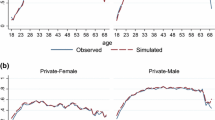Abstract
This paper is concerned with the analysis of intergenerational redistribution in a pay-as-you-go financed social security scheme. Instead of annual fiscal indicators, we apply generational accounts to calculate the intertemporal effects arising from a projected aging process. As a case study, the institutional settings and the parameterization of our model refer to the conditions found in Germany in 1989. Additionally, the intergenerational impacts of the German 1992 Pension Reform Act are taken into account. Our findings suggest that the major reform measures affect the distribution of the demographic burden between future and presently living generations. However, the burden is shifted in favor of the generations currently alive, thereby contradicting the explicit political intentions and aggravating the situation for future generations.
Similar content being viewed by others
References
Aaron, H.J. (1966). The social insurance paradox.Canadian Journal of Economics and Political Science 32: 371–374.
Auerbach, A.J., Gokhale, J. and Kotlikoff, L.J. (1991). Generational accounts: A meaningful alternative to deficit accounting.NBER Working Paper No. 3589. Cambridge, MA.
Auerbach, A.J., Gokhale, J. and Kotlikoff, L.J. (1992). Generational accounting: A new approach for understanding the effects of fiscal policy on saving.Scandinavian Journal of Economics 94: 303–318.
BMA — Bundesministerium für Arbeit und Sozialordnung (1990).Arbeits- und Sozialstatistik, Hauptergebnisse 1990. Bonn.
Börsch-Supan, A. (1991). Aging populations: Problems and policy options in the U.S. and Germany.Economic Policy 12: 104–139.
Börsch-Supan, A. (1992). Population aging, social security design, and early retirement.Journal of Institutional and Theoretical Economics (JITE) 148: 533–557.
Breyer, F. and Straub, M. (1993). Welfare effects of unfunded pension systems when labor supply is endogenous.Journal of Public Economics 50: 77–91.
Casmir, B. (1989).Staatliche Rentenversicherungssysteme im internationalen Vergleich. Frankfurt a.M.: Peter Lang.
Felderer, B. (1983).Wirtschaftliche Entwicklung bei schrumpfender Bevölkerung. Berlin, Heidelberg, New York, Tokyo: Springer.
Felderer, B. (1992). Can immigration policy help to stabilize social security systems? Paper presented at the Euresco Conference ‘The Economics of Aging’, San Feliu de Guixols, Spain. Mimeo.
Homburg, S. (1990). The efficiency of unfunded pension schemes.Journal of Institutional and Theoretical Economics (JITE) 146: 640–647.
Kleindorfer, P.R. and von der Schulenburg Graf, J.-M. (1986). Intergenerational equity and fund balances for statutory health insurance. In: J.-M. Graf von der Schulenburg (Ed.),Essays in social security economics. Berlin, Heidelberg, New York, Tokyo: Springer.
Kotlikoff, L.J. (1993). From deficit delusion to the fiscal balance rule — Looking for a sensible way to measure fiscal policy.Journal of Economics, suppl. 7: 17–41.
OECD — Organization for Economic Co-operation and Development (1988).Ageing populations. Paris.
Raffelhüschen, B. (1989).Anreizwirkungen des Systems der sozialen Alterssicherung. Frankfurt a.M.: Peter Lang.
Raffelhüschen, B. (1993). Funding social security through Pareto-optimal conversion policies.Journal of Economics, suppl. 7: 105–131.
Schmähl, W. (1992). Changing the retirement age in Germany.The Geneva Papers on Risk and Insurance 17: 81–104.
Statistisches Bundesamt (1991).Statistisches Jahrbuch 1991. Stuttgart: Metzler — Poeschel.
Statistisches Bundesamt (1992).Siebente koordinierte Bevölkerungsvorausschätzung, Basis: 31.12.1989, Die 11 alten Länder. Wiesbaden.
VDR — Verband Deutscher Rentenversicherungsträger (1989).Statistik Rentenbestand 1. Januar 1989. Frankfurt a.M.
VDR — Verband Deutscher Rentenversicherungsträger (1991).Statistik Pflichtversicherte 1988/1989. Frankfurt a.M.
Author information
Authors and Affiliations
Additional information
We would like to thank two anonymous referees and the participants of the Euresco conference on ‘The Economics of Aging’, 10–15 October 1992, San Feliu de Guixols, Spain, for their helpful comments.
Rights and permissions
About this article
Cite this article
Boll, S., Raffelhüschen, B. & Walliser, J. Social security and intergenerational redistribution: A generational accounting perspective. Public Choice 81, 79–100 (1994). https://doi.org/10.1007/BF01053267
Accepted:
Issue Date:
DOI: https://doi.org/10.1007/BF01053267




